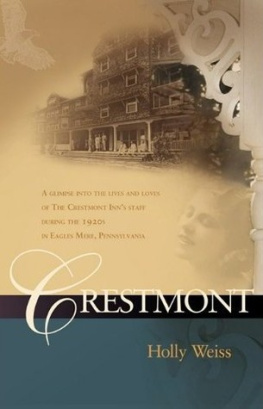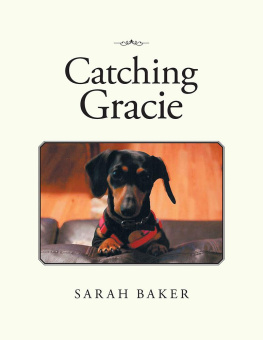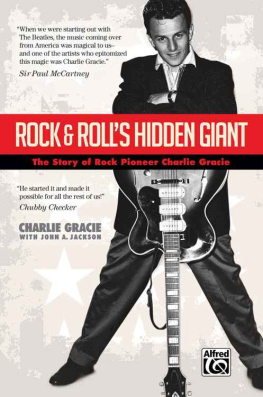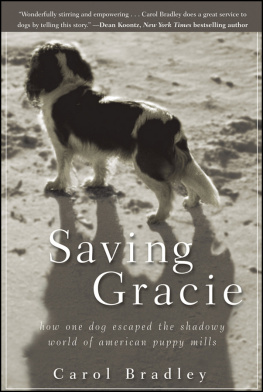Crestmont
Holly Weiss
ALL RIGHTS RESERVED
No part of this book may be reproduced in any form, by photocopying or by any electronic or mechanical means, including information storage or retrieval systems, without permission in writing from both the copyright owner and the publisher of this book, except for the minimum words needed for review.
Edited by Star Publish LLC
Cover Design by Catherine D. Brown
Print edition published in 2008 by Star Publish LLC
Trade Paperback ISBN 13: ISBN: 978-1-935188-10-0
Ebook ISBN: 978-1-935188-26-1
Available at online and offline book sellers
All scripture quotations, unless otherwise indicated are taken from the King James Bible.
Psalm 68:4,6, marked TLB, taken from The Holy Bible, New Living Translation.
Tyndale House Publishers, copyright, 2002.
A Star Publish LLC Publication
www.starpublishllc.com
In memory of my parents,
N. John and Dorothy L. Weiss
Who nurtured my other voice singing.
Authors Note
I was inspired to write this novel when my husband, Ernie, and I stayed overnight at The Crestmont Inn in November, 2006. The restful atmosphere of the inn, the graciousness of innkeepers Fred and Elna Mulford, and the beauty of the surrounding area captivated me. More importantly for this work, the rich history of the inn struck me. We stayed in The Evergreen Lodge, which was converted into its current form from staff quarters built in 1926. Small staff rooms that housed two or three waitresses in the 1920s through the 1970s were cut through to create the large and luxurious suite where we stayed. Original transoms over the doors and antiques from the inns early years perked my interest about how these staffers lived and worked. I have attempted to remain faithful to the spirit of the Crestmont in my imaginings of their stories.
William and Mary Warner, William and Margaret Woods and Peg Woods Dickerson are actual people who, at various times, administered the original Crestmont Inn. Eleanor Woods was the younger of the two Woods daughters. Sid Fox served as faithful steward from 1901-1947. All of their names and dates are real. Their characterizations and that of opera singer Rosa Ponselle are wholly the authors creation and in no way are intended to represent their real lives. Warren Sloan was my maternal grandfather. He invented the automatic pinsetter with his partner, Joe Clark, and later sold the patent to AMF Bowling. The other Crestmont staff, guests, and residents of Eagles Mere are entirely fictional.
In an attempt to steep myself in the historical knowledge necessary to lend the novel authenticity, I made numerous visits to Eagles Mere and The Crestmont Inn during the writing of this book. I interviewed not only the Mulfords, current owners, but also former employees of the inn. Shopkeepers and residents of the town shared stories with me. Thanks to all who fueled my enthusiasm to research a place about which they are impassioned.
Writing fiction affords the author the flexibility to modify events to suit the story. Although I endeavored to maintain the spirit of Eagles Mere, I found it necessary to make some revisions in its physical and historical detail. I expanded the size of the lake to give shore front to The Crestmont Inns property. The reader may note certain liberties taken in historical dates, such as the inception of the tennis tournaments. I hope others who love Eagles Mere will be forgiving of any modifications necessary to make the narrative plausible and enjoyable.
The Crestmont Inn, a unique historic country inn, is a hidden treasure in the northern foothills of the Appalachians. It is nestled in the mountaintop town that seems timeless, Eagles Mere, Pennsylvania, which is listed in the National Register of Historic Places. Beautifully appointed rooms, sumptuous dining, gracious innkeepers and attention to detail are some of the many reasons to visit the inn. Set on the highest point in the picturesque Victorian village, the inn is surrounded by state parks, breathtaking vistas, and one of natures wonders, pristine Eagles Mere Lake.
There have been many attempts to explain how the mountaintop lake came to be. I gave a new twist to an old Indian legend. I hope a spirit of healing is reflected in my retelling of the story.
Bush and Barbara James, former employees of The Crestmont Inn, reflect on Eagles Mere. To really understand Eagles Mere is to knowthat indeed the stars do shine a little brighter here, the lake is purer, the air fresher, the wild flowers more abundant, the people friendlier; and life moves inexorably slower so that what little time we are permitted can be more fully spent in escaping to our private island on the mountain.
It is not by idle chance that I have come here.
Latin proverb
Sing praises to the Lordoh, rejoice in his presence.
He gives families to the lonely
Psalm 68:4, 6 TLB
Prologue
Eagles Mere, Pennsylvania
I will arise and go now, for always night and day
I hear lake water lapping with low sounds by the shore
I hear it in the deep hearts core.
William Butler Yeats
The Eagle rested on the hemlock, quiet but intent. His dark brown plumage blended with the branches, his yellow hooked bill the only hint of his presence. He watched for the coming of spring and for the enemy of the deer. His keen eyesight, coupled with his ability to swivel his head, enabled him to see the Haudenosaunee moving across the land from the north. Spreading his majestic wings, he soared high, willing the approaching Native Americans to feel his disapproval and change direction. He did not fear for his own safety, for he knew the Haudenosaunee revered him, but he sensed impending danger for his friends, the scarce white deer.
The Haudenosaunee, also called the People of the Long House, ignored his entreaty and continued their approach. When they reached his mountain, he called to warn the deer. They clambered for safety up a small hemlock-covered hill that rose above the valley, sacred in its peacefulness, home of the swallows and bluebirds.
Ever mindful of his familys hunger, the eagle sought the mice and squirrels that breakfasted upon the succulent Juneberry bush. He swooped down, grabbed his prey with his talons, and soared over the valley to his nest. The basin he crossed was cut into a mountain, with springs of water rising from its floor. Rhododendron, mountain laurel, hemlock and white pine gave eagles nesting places for their families and shelter from the wind.
Stormy Torrent, chief of the Haudenosaunee, gazed respectfully at the soaring eagle and felt its presence a good omen for his peoples hunting. Annually, after the Maple Festival in the spring, he led his people south from the lakes shaped like fingers to find new planting grounds for the corn, beans and squash that sustained them. Some of his people still wore the cornhusk foot coverings from last harvest. He needed to find deer for venison and leather for tunics, leggings and moccasins. A mountain rose before him. Thrusting his spear upward, he began to climb. Obediently, his people followed. He anticipated the aroma of venison smoking and the dancing and singing of the women and children for the joy of sustenance. His newly captured Susquehannock slave, Laurel Eyes, would keep him warm at night.
Laurel Eyes, frightened and angry, labored behind him with her packs. Her tribe, the Susquehannock or the People of the Muddy River, had refused to join the Five Nation League and were thus hated by the Haudenosaunee. Capturing her was a conquest bestowing great honor on Stormy Torrent. The Haudenosaunee women equally shared respect, leadership and the carrying burden with the men in the tribe. Laurel Eyes, however, struggled not only with her own pack but also his, her strength fueled by hatred. He had wrenched her away from her life. Now she longed for her life to be over.
Next page








